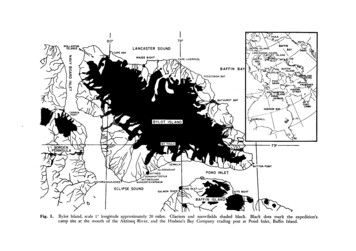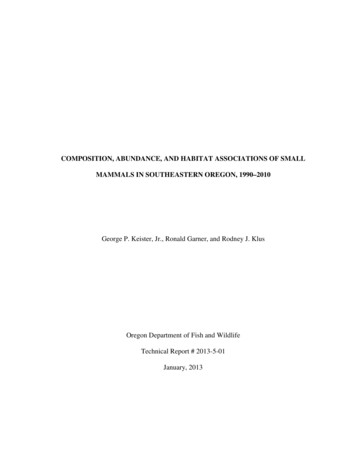
Transcription
ASURVEY OF THE MAMMALS OF BYLOTISLAND,NORTHWESTTERRITORIESRichard S. Miller*T1954 Bylot Island expedition was organized under the auspices of theArctic Institute of North America, with additional support from the NewYork Zoological Society, to survey the flora and fauna of Bylot Island, and tostudy certainecologicalproblems.A generaldescription of the activities ofthe expedition has been prepared (Drury, 1954) but the present paper reportsonly on the mammals of Bylot Island and its surrounding waters. It is basedmainlyonobservationsmadeinthe field by the writer and othermembersof the expedition;data were also thePondInletDetachmentof theRoyalCanadianMountedPolice,andthefurreturnsof theHudson's Bay Cosmpany weremade available to us. Discussion with the Tununermiut Eskimo proved mostvaluable, as they are accurate and reliable observers and could provideinformationon tterinformed than others about particularanimal species, and every attempt wasmade to take advantage of this.Most of the Eskimo live on the shores of Pond Inlet, Eclipse Sound, TaySound, and Navy BoardInlet. There is one permanent camp a t Iglookashaton Bylot Island, and a summer camp at Button Point. Hunting and trappingis confined mainly to Baffin Island and the south coast of BylotIsland, butoccasionally theEskimo travel as far north as LancasterSoundandtheWollaston Islands, and to Maud Bight on the northeast coast of Bylot Island.They trade a t Pond Inlet and make it their summer headquarters, so they wereavailable for frequent questioning.Idlouk, the most energetic and skilled hunter of the Tununermiut group,was of various animal specieswere extremely valuable.Bylot Island is about 4,000 square miles inarea,andis separated fromBaffin Island bythewatersof PondInlet,EclipseSound,andNavy BoardInlet (Fig. 1). T h e surface of the island consists mainly of rocky peaksprojectingthroughhighlandice(Fig. 2), and theonly extensive lowlandsare on the southwest andnortheast coasts. A central mountain range formsa broad ridge along the axisof the island, stretching from Wollaston Islandsin the northwest to Button Point in the southeast.HE*Experiment Station, ColoradoAgricultural and Mechanical College.167
168A SURVEY OF THEMAMMALSOF BYLOTISLANDThe expedition camp was established on lowland on the south shoreofthe island, just west of the mouth of the Atkineq River, on 14 June 1954, andmaintained until July 3 1. Observations were made at points along the southcoast from Button Point to Ooyarashukjooet. During the frequentcrossingsbetween the Bylot Island camp and Pond Inlet, a distanceof about twentymiles, and on other dogsled trips on the sea ice of Pond Inlet andEclipseSound,observationsonaquaticmammals were possible.T h e vegetation of the south coast, the only area visited by the expedition,varies with the topography, exposure to sun and wind, and frost action. Thedominantvegetation is Salix arctica, Dryas integrifolia, and Luzula confusa.Luzula confusa is particularly abundant on exposed, well-drained soils, whereit forms a complex withSaxifraga oppositifolia, Papaver radicatum, and thelichens Stereocmlon and Cetraria. Sheltered areas withmoremoisture have
A SURVEY OF THEMAMMALSOF BYLOTISLAND169heavier growths of mosses and Cassiope tetragona, while the exposed, windblown areas andextremelywell-drainedsoils arecharacterizedby lichens,Papaver saxifraga, and Salix. Salix herbacea is characteristic of places shelteredfrom wind and sun, where snow tends to accumulate and remain for a longtime.Lemming mounds are the centresof a distinct vegetation complex. Progressive burrowinginto solifluction lobes, frost cracks,and at the bases ofboulders, and the accumulation of fecal material seems to contribute to a lush,grassy vegetation.Mammal speciesThe Tununermiut names for the animals have been listed for the convenience of others who might study in this area. These names were provided bythe Pond Inlet Eskimo, through Peter Murdoch,of the Hudson’s Bay Company,who interpreted their references and spelling.Species determinationswere,in most cases, made directlyfromfieldobservations with reference toBurt andGrossenheider (1952). Species notactually observed by members of the expedition were identified by the Eskimofrom the illustrations in Burt and Grossenheider. Repeated tests showedthatsuchidentifications erences were noted. The specific namesused arethose listed by Millerand Kellogg (1955).Thalarctos maritimus. Polar Bear. Nanook.Polar Bear are knownfromtheWollastonIslands east alongthenorthcoast of Bylot Island and along the east coasts of Bylot and Baffin islands. Therelativeabundance of this species is difficult to determine, since bearsareseldom hunted anywhere but a t the floe edge of Pond Inlet. The total annualkill by the Pond Inlet Eskimo is estimated a t about 20 to 25, but as the hidesare rarely traded there is no reliable index of numbers. Idlouk says that morebears could be taken if the hunters were to go farther afield and search forthem.Mustela erminea. Short-TailedWeasel.Tereak.According to the Eskimo,weasels are common along the southerncoast andon thelowlandsbetweenCanadaPointandIglookashat. Several were seenby members of the expedition, usually near river beds, but once a t an altitudeof 3,500 feet at the edge of Sermilik Glacier.Alopex lagopus. Arctic Fox. Terereneak.This species is foundthroughoutthelowlandsof Bylot Island and isparticularlyabundantalongthesoutherncoast.Table 1 showsthenumber of fox trapped annually by the Pond InletEskimo forthe past thirty-two years. These data arefromtheHudson’s
170A SURVEY OF THE M A M M A L S OF BYLOT ISLANDBay companyfurreturns, in which a season is theperiodfromJuly1toJune 30 of thenextyear.T h e estimates o'f s. T h e recordsforbothfoxandlemmingare illustrated graphically in Fig.3.Table 1. Seasonal abundance of arctic fox and lemming in the Pond 333 41924-251925-261926-271927-281928-291929-301930-3 945-461946-471947-481948-491949-50195W511951-52. 1952-531953-54 . .-071very abundantvery abundantvery abundantscarcescarce700844933102034298813098395035 7053185 71347350536 undantincreaseIncreasevery abundantscarceI. Published by permission of the Fur Trade Department, Hudson's Bay Company.The periodicity of the maxima and minima in the data for fox numbersis shown in Table 2. T h e value of 318 for 1921-22 r,andhas notbeen included.Authors disagree as to how peaks should be chosen, but the figure of570 forthe 1948-49 season (Table 1) has not been treated as a peak, on the groundsargued by Butler(1953).Thusthe values shown in Table 2 give a meanperiodicity o'f4.0 years for the maxima and minima, conforming to the usualperiodicity assigned to this species in this part of itsrange(Chitty,1950,Table 2. 7-381942-431945-461950-51TotalMeanthe maxima and minima of furreturnsforarcticPond Inlet area from 1921-22 to 1953-54.Interval3 1939-401943-441947-481951-52fox in theInterval4 years443444274.0
171A SURVEY OF THE M A M M A L S OF BYLOTISLANDNyNEg?EEN%08cFig. 3. Hudson’s Bay Company fur returnsforarcticfox at PondInletfromto ws.1921-22pp. 182-3; Butler, 1953, pp. 246-7). It should be notedthatthe periods ofrelativeabundanceandscarcityof each of the “cyclical species” on BylotIsland correspond with those on Baffin Island.Canis lupus. GrayWolf.Amarok.Wolves have not been seen on Bylot Island since the elimination of thecaribou herd in 1943.Phocohispida.Ringed Seal. Netchek.This is the common seal in the waters around Bylot Island and throughoutthis part of the eastern Arctic, and it is the principal animal in the economyof Eskimo. There is no reliable way of estimating its numbers or how manythe Eskimo kill. Idlouk, who keeps an account of his game kill, says that hisyearly kill is between 200 and 300; Idlouk is an exceptional hunter, but he alsosupplements his diet withother animals.IfIdlouk‘saverage wereextendedto the other hunters, it would mean an annual total kill of about 11,250 seals.T h e stomachs of S seals taken in Eclipse Sound and Pond Inlet containeda large species of gammarid,whichtheEskimoclaim is the principal preyof the ringed seal, young and adults alike. During the spring and summer theseals do not seem to eat many fish, even though arctic char (Salztelinus alpinus)areabundant. On several occasions seals were seen amongtheice floes atheredduring
172A SURVEY OF THE M A M M A L S OF BYLOTISLANDtheir migration, but the seals did not move inshore to feed on the fish nor didthe stomachs of seals taken in this area containfish.Phoca groenlandica. Harp Seal. Kyrolik.T h e harp or saddleback seal is found in Pond Inlet and Navy Board Inletat the end of July or early in August, during an annual migration into TaySound, south of Eclipse Sound. These seals are quite numerous at Guys BightTable 3.Arrivaldateof te of ice break-up,yearlysince1946.YearArrival of narwhaland bearded seal19461947194819491950195119521953195430 July26 July1 August26 July25 July21 July25 July23 July18 JulyDate ofIce break-ufi11 August7 47Date' estimated by Idlouk, on basis of ice conditions up to July 31.and in thenorthernmostwatersof Navy Board Inlet, both close to theirnormal migration route in B a n Bay; fairly large numbers enter Eclipse Soundfrom NavyBoard Inlet and Pond Inlet and pass into TaySound along the samemigrationpathfollowedby narwhal. They stay in TaySounduntilaboutSeptember 2 5 and move out again into the open sea as ice begins to 'form.Erignathusbarbatus.Bearded Seal. Oogjuk.T h e Eskimo report that bearded seals sometimes winter in Eclipse Soundand Pond Inlet, but they are usually seen only in summer. Since these animalsare rather solitary and prefer open water, they are never very abundant in thisarea.Bearded seals invariably enterthe inlandwatersonthe same day asnarwhal. Table 3 shows the annual arrival of bearded seal and narwhal compared with the dates of ice break-up in these waters. These records are fromthe annual log kept by Idlouk, who defines the ice break-up as the first daya boat can safely cross Eclipse Sound. When the expedition left Bylot Islandan July 31, Idlouk correctly estimated that it would be another week beforethe ice on Eclipse Sound would be open.T h e t w ospecies are seen as much as twelve days before the ice breaks up,but show only eleven days range in their dates of arrival over the period forwhich data are available, as compared with a range of twenty-five days in thedates of ice break-up. Since 'the ice sometimes remains in the sounds until thesecond week of August and begins to reform about the middle of September,the migratory movements of mammals that prefer open water are restrictedto a short period in this area. T h e bearded seal and narwhal are, however, ableto use limited spaces of open water and can move into the sounds and inletsbefore they are free of ice.
A SURVEY OF THE MAMMALS OF BYLOT ISLAND173Cystophora cristata. Hooded Seal. Apa.A few hooded seals occasionally enter Pond Inlet and Eclipse Sound inthe summer with harp seak; no more than 3 have ever been seen in a year.The Eskimoare,however,familiarwiththehoodedseal andrecognize itreadily by its habit of swimming low in the water with only the topof thehead exposed and by the inflatable sac on the nose omf the males.Odobenus rosmarus. Walrus. Zzrik.One of the northernmost breeding grounds of the walrus is the WollastonIslands, off thenorthwesttipof BylotIsland, but walrusarereportedlyabundant all through LancasterSound.ThePondInletEskimogenerallyhunt them along the floe edge of Pond Inlet and the total kill is only about10 eachyear. A few of the Eskimohavemadeboattripsto the WollastonIslands to hunt; their reports of the population size vary considerably and areprobablynot reliable. T h e mostconservativeestimateplaces thebreedingpopulation between 200 and 300 adults.Lemus trimucronatus. Brown Lemming. Auignak, K q o o k .No brown lemmings were found by the expedition, either on Bylot Islandor B a n Island, although both are within its range of distribution (Miller andKellogg, 1955, p. 566). T h e Eskimosay thatthebrownlemming is foundon the island, but is not as common as the Greenland collared lemming. redlemmingsfromillustrations, and though the word avignnk is used for any lemming, they havedifferent names for the two species.Dicrastonyx groenlandicus. GreenlandCollaredLemming.Auignak, Amglak.T h e summer of 1954 was a period of lemming scarcity, following a peakin 1953, and only 4 Dicrostonyx were taken; one of these was from a strictlynatural habitat on Bylot Island, the other 3 were living under the buildings ofthe Hudson’s Bay Company at Pond Inlet.This species reportedly reaches high densities in the southwest lowlands,wherefavourablehabitatis most extensive. A particularlyintensivesearchfor lemmings and snowy owls was made in the vicinity of Ooyarashukjooeet,where they had been most abundant in 1953. Except for sand or gravel areaswhere vegetation was sparse,it was impossible to walk across the tundra slopeswithout stepping on lemming runs or burrows, yet trapping was fruitless andall evidence of lemming activity proved to be from previous years. Only onesnowy owl was seen and very few of a large sample of owl pellets were fresh.T h e vegetation in this area was examined closelyfor evidence 0.f heavybrowsing or damage to food plants by lemmings. T h e stems of some 04 theolder willows had been barked, but not extensively, and there was nothing toindicate that food or habitat conditions were unfavourable. If, as some authors
174A SURVEY OF THE MAMMALS OF BYLOT ISLANDmaintain (Lack, 19.54, pp. 214-6, 223, 226), food is a primary factor in lemming“crashes”, the effect on the flora should be apparent in the years followingpeaknumbers. T h e Eskimo report that Salix arctica is the principal food plant ofthe lemmings, although they will also eat most of the other herbs and grasses;captive lemmings ate the young leaves of all willow species and the stems andleaves of Carexmisandra andseemed to stay healthy. These plants wereabundant everywhere in the tundra.None of the Eskimo had seen a lemming migration, and sucha thing isnot recorded in their folk tales. They have seen lemmings on ice floes a t thewater’s edge during periods of high numbers, but never more than a fewat atime.Lepus arcticus. ArcticHare.Okalek.A few arctic hares are found on the lowlands of Bylot Island. They arenever as abundant on Bylot Island as they are near Pond Inlet, but ous in the two populations.This was learned from the Arctic Wildlife Enquiry reportsand from statements by the natives.Rangifer arcticus. BarrenGroundCaribou.Tuktoo.For some years caribou were known to be on the northeast coast of BylotIsland. The only route to this area is along the east coast where the ice is oftenimpassable during winter, and the caribou were, therefore, beyond the reachof native hunters. In 1941, however, for the first time in several years, a partyof Eskimo was able to negotiate the ice along the comast and found a fairlylargeherd on thelowlandsnearCapeLiverpool. They killed 149 deer. In1942 another caribou hunt was organized; the herd was found between Bathurstand Possession baysand 24 caribouwereshot.In1943 ahuntingpartyjourneyed to the north coast and killed 300 caribou in the area between MaudBight and Cape Liverpool. Few if any survived this last onslaught, and subsequent attempts to find caribou on the island have been unsuccessful.The Tununermiut are coastal people and rarely venture more than a fewmiles inland, so that if the caribou could move to an inland area they wouldprobablynot be molested.BylotIsland does not affordsuch a refuge,andsince there are very few areas that can support caribou, it is therefore improbable that this species will ever survive onBylot Island unless completelyprotected.Balaena mysticetus. Bowhead Whale. A kbilk.FollowingParry’svoyage to Possession Bay in 1819, the waters off theeast coast of Bylot Island becameone of the mostfamous of thenorthernwhaling grounds and the floe edge at Button Point was visited frequently bywhalers during the next half century. Now, seldom more than a few whalesare seen each year off Button Point and only occasionally do they enter PondInlet and Navy Board Inlet.
A SURVEY OF THE M A M M A L S OF RYLOTISLAND175Whale skeletonsarefairlynumerousalongthe beaches of Pond Inlet,EclipseSoundandNavy BoardInlet,andaresometimes found on raisedbeaches as much as two miles inlandand 200 feetabovethepresentshore.T h e Eskimo have no stories to account for these skeletons. The identificationof this species wasmade by W. Schevill (personalcommunication)fromphotographs of skulls found along the beaches.Grampus or-.Atlantic Killer Whale. Ahgluk.At least 10 to 20 killer whales are seen in Eclipse Sound and Pond Inletevery August, apparently following the migratorymammals already discussedand preying on the ringed seals. The whales, in packs, drive the seals inshorewhere they are easy game for the This species is fairly common in Lancaster Sound where about 100 to 200are seen in June and July each year at the floe edge of Pond Inlet. Sometimes10 or 15 are seen in the inland waters of EclipseSound,usually in August,but this is not a regular occurrence.Monodon monoceros. Narwhal. Kilaluga.During late July narwhal enter Navy Board Inlet from Lancaster Sound,and Pond Inlet from Baffin Bay; they generally follow two migration pathsthat converge in Eclipse Sound off the southwest tip of Bylot Island. Between500 and 1,000 are seen alongthesoutherncoast of the island every year,travelling in groups ofas many as 200. From Eclipse Sound they move southice begins to form in September. Asinto Tay Sound where they stay untilmentioned earlier, the arrival of this species invariably coincides with that ofthe bearded seal.T h e first narwhal seen on this expedition were in anarea of open waterat the mouth of the Aktineq River on the morning of July 18. Their progresscould be followed from some distance, by 'the sound of their blowing whenthey surfaced. Several were located in this manner and observed from the iceat close range as they passed along the leads. Of the 22 narwhal seen be,tweenJuly 18 and 30, only 4 hadtuskssufficiently prominent to identify themasmales.T h e Eskimo had reported that narwhal often surface in seal holes, whichare enlarged late in the season by the runoff of melt water from, the surfaceof the ice.Sincethelargestof these holes is seldommore than fifteen ortwenty feet in diameter, this seemed somewhat improbable; however, 4 femaleswere watched for about ten minutesas they surfaced, one or two at a time,in a single seal hole which was not more than eighteen or twenty feet across.They seemed to maintain a steady rhythm of rising, heads pointed upwards,then sliding back beneath the surface, and continued to surface in this fashionuntil we had crept to within about twenty feet of them.Whaleswithtwotusksare sometimes seen. Idlouk has a photographof a narwhal killed in T a y Sound in 1953, with one tusk four feet longand
176A SURVEY OF THE M A M M A L S OF BYLOTISLANDthe other three feet long. T h e Pond Inlet Eskimo think that the narwhal tusksare used in fighting, but can give no real evidence to support this hypothesis.I wish to thank the Hudson’s. BayCompany for permission t o publishthe furreturnsshown in Table 1. I amalso gratefultoPeterMurdochoftheHudson’s Bay CompanyandConstableMoody,of theRoyal CanadianMounted Po81ice, for help and adviceduring this study, and especially toEskimo Idlouk,whosecompanionshipand contributionswere invaluable.ReferencesBurt, W. H. and R. P. Grossenheider. 1952. ‘A field guide tothe mammals’. Boston:xii200 pp.Butler, L. 1953. “Thenature of cycles in populations of Canadian mammals”. Can. J.Zool. Vol. 313, pp. 242-62.Chitty,Helen.1950. “Canadian Arctic wildlife enquiry, 194349: with asummaryofresults since 1933”. J. Anim. Ecol. Vol. 19, pp. 180-93.Drury, W. H. 1954. “The 1954 Bylot Island Expedition”.UnpublishedMS.Lack, D. 1954. ‘Thenatural regulation of animal numbers’. Oxford: viii 343 pp.Miller, G. S., Jr. and R. Kellogg. 1955. ‘List of North American recent mammals’. U.S.Nat. Mus. Bull. No. 205, xii954 pp.
The harp or saddleback seal is found in Pond Inlet and Navy Board Inlet at the end of July or early in August, during an annual migration into Tay Sound, south of Eclipse Sound. These seals are quite numerous at Guys Bight Table 3. Arrival date of bearded seal and narwhal in Eclipse Sound, compared with











